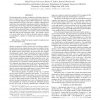Free Online Productivity Tools
i2Speak
i2Symbol
i2OCR
iTex2Img
iWeb2Print
iWeb2Shot
i2Type
iPdf2Split
iPdf2Merge
i2Bopomofo
i2Arabic
i2Style
i2Image
i2PDF
iLatex2Rtf
Sci2ools
ICASSP
2011
IEEE
2011
IEEE
A partial least squares framework for speaker recognition
Modern approaches to speaker recognition (verification) operate in a space of “supervectors” created via concatenation of the mean vectors of a Gaussian mixture model (GMM) adapted from a universal background model (UBM). In this space, a number of approaches to model inter-class separability and nuisance attribute variability have been proposed. We develop a method for modeling the variability associated with each class (speaker) by using partial-least-squares – a latent variable modeling technique, which isolates the most informative subspace for each speaker. The method is tested on NIST SRE 2008 data and provides promising results. The method is shown to be noise-robust and to be able to efficiently learn the subspace corresponding to a speaker on training data consisting of multiple utterances.
Gaussian Mixture Model | ICASSP 2011 | Nuisance Attribute Variability | Signal Processing | Universal Background Model |
Related Content
| Added | 20 Aug 2011 |
| Updated | 20 Aug 2011 |
| Type | Journal |
| Year | 2011 |
| Where | ICASSP |
| Authors | Balaji Vasan Srinivasan, Dmitry N. Zotkin, Ramani Duraiswami |
Comments (0)

